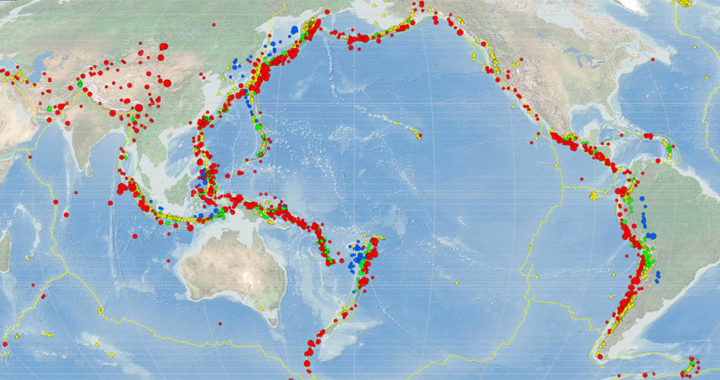The Pacific Ring of Fire or the Circum-Pacific Belt is a geologically defined path along the Pacific Ocean characterized by a string of active volcanoes and frequent earthquakes. It has a length of approximately 40,000 kilometers or 24,900 miles spanning from the western sides of the South America and North America and all the way up the northernmost portion of the northern hemisphere, and further to the easternmost portion of Siberia and down to Japan, Southeast Asia, New Zealand, and Antarctica.
Note that the area has 452 volcanoes or about 75 percent of the active and dormant volcanoes in the world. About 95 percent of earthquakes and, more specifically, about 81 percent of the largest earthquakes in the world occur along this path. Nevertheless, the Pacific Ring of Fire has been dubbed as home to some of the most dangerous places on Earth due to the frequency of geological activities.
Why is the Pacific Ring of Fire Prone to Earthquakes and Volcanic Eruptions?
Plate Tectonics Theory
Plate tectonics is the primary reason why the Pacific Ring of Fire is prone to both earthquakes and volcanic eruptions. In the field of geoscience, plate tectonics is a theory describing the large but slow motions of 7 major plates and movements of a larger number of smaller or minors plates of the lithosphere.
The theory of continental drift is also the basis of plate tectonics. Introduced in 1596 by Abraham Ortelius and developed further during the first decades of the 20th century, continental drift asserts that the continents of the Earth have moved over geologic time relative to each other, thereby appearing to have drifted across the ocean bed.
It is also worth mentioning that the lithosphere is the rigid outermost shell of the mechanical layer of the Earth composed of the crust and the upper mantel. Because the lithosphere is broken into 7 major and hundreds of minor tectonic plates, alongside the fact that the mantle dissipates heat, it naturally moves. The interaction between plates can result in oceanic trench formation, mountain-building, earthquakes, and volcanic activities and eruptions.
History of the Ring of Fire
Numerous maps developed by geoscientists from the past have indicated areas along the edges of the Pacific with heightened and frequent geological activities. For example, maps from the 1850s have identified the Volcanic Series of Australasia and the Volcanic Series of Japan and Kamchatka in Russia. In fact, these early maps have identified other volcanic series along the currently identified Pacific Ring of Fire.
There is indeed an emerging scientific consensus that the edges of the Pacific have notable geologic activities. However, it took another hundred years before scientists agreed to a single theory explaining why the Pacific Ring of Fire is prone to earthquakes and volcanic eruptions.
By the 1950s to 1960s, the majority of the geoscientific community has accepted the plate tectonics theory or, in other words, has agreed that the lithosphere is made of tectonic plates that slowly move into, against, or apart from each other.
Plates in the Pacific Region
The Pacific region includes 3 of the 7 major tectonic plates and two of the largest smaller plates. The three major plates include the Pacific Plate that meets the North American Plate in the north and the Australian Plate in the southwest. Several minor tectonic plates also meet the Pacific Plate, including the Nazca Plate in the east and the Philippines Sea Plate in the west.
Most portions of the Ring of Fire consist of plates overlapping at convergent boundaries called subduction zones. Convergent tectonic plates move against each other, causing a plate to be subducted by another plate above. When pushed down the surface, the rock in the subducted plate melts and becomes magma that, in turn, gives rise conditions ripe for volcanic activity and seismic movements or earthquakes.
Note that the movements involving the Pacific Plate and North American Plate are characterized by a transform boundary and not a convergence. What this means is that the plates move sideways past one another.
To put things in a better perspective, the Pacific Plate converges with the northern portion of the North American Plate, thus resulting in the formation of volcanoes in the northern hemisphere. The same movement of the Pacific Plate grinds the western portion of the North American Plate, thereby resulting in the San Andreas Fault on the American west coast.
It is still important to note that the plate interactions along the Pacific Ring of Fire are generally independent of each other. For example, a significant movement of the Nazca Plate would not result in the movement of the Australian Plate or the Philippine Sea Plate.





